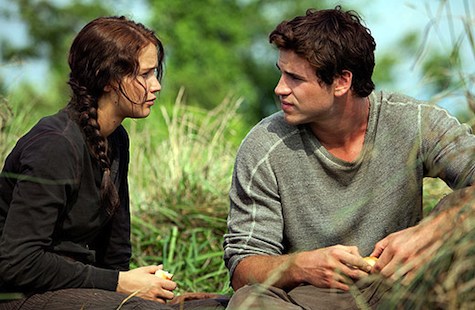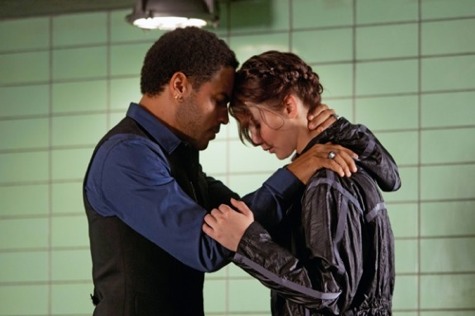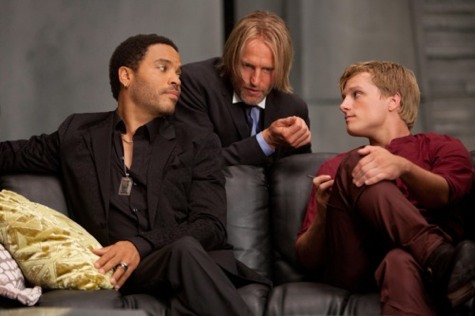One of the immediate questions that flies when you bring up the words “Hunger Games” and “men” in the same sentence is “Gale or Peeta?” The instant bias toward the Top Two is almost funny; The Hunger Games series has a slew of interesting male characters who all have their own “type” to play into, even if Katniss isn’t interested in their charms.
Don’t believe me? Maybe it’s about time we examined romantic tropes foisted on men in The Hunger Games. Gale and Peeta follow the specific guidelines fiction usually dictates for the “competing suitor” scenario, but they’re not the only fellas worth mentioning, all of them designed to get a specific reaction out of female (and also potentially male GB) readers. How are they being offered up and which one of them melted your heart like butter in a frying pan?
(Warning: Spoilers for the series.)
Gale Hawthorne

It starts with Gale. Gale the best friend, the hunting partner and confidant, the dependable yet fiery companion. He knows Katniss better than any male character in the series, and you could make the case that he truly understands her better (except there’s Haymitch, who seems to understand her at an unromanticized level, which is ultimately more helpful). I’ll cop to being more Team Gale at the beginning — I’m a sucker for the “best friend turned lover” relationship above all other options, so I’m easily swayed on that account. It might be the easiest manipulation of all, which is probably why Collins chose to offer Gale at the outset: beginning with someone who loves our protagonist deeply as she is, no holds barred, is instantly attractive. Gale knows Katniss’ foibles and adores her regardless. And hey, the fact that he’s ridiculously attractive (and also likely reminds Katniss a bit of her dead father in look and ability—it’s creepy, but you can’t count the possibility out —) can’t hurt.
There’s also the fact that Gale and Katniss have already formed a unit that resembles marriage in many respects; they work together to provide for each other’s families and share a unique relationship completely outside all the other connections they have. If they hadn’t made the choice to work together, all of their loved ones would have likely starved. Why mess with a good thing? They’ve already been guarding each other, taking care of each other for quite some time.
Going against Gale is the fact that he might have too much in common with Katniss, and also the fact that he’s a bit too bloody-minded for his own good. But that’s part of Gale’s type: he’s the rugged provider, the man who you can rely on for protection and a strong arm. He’s tough and handsome and honest. Not exactly a hard sell.
Peeta Mellark

And then there’s Peeta. Peeta’s the romantic, the artistic one who helps people in need. He’s almost too nice, and it works against him at the start. The belief that someone could honestly be that good is hard to buy, even from a reader’s perspective. When you break it down, Peeta’s faults aren’t even his own; he gets brainwashed and it makes him all kinds of twitchy. He falls under a more archaic romantic stereotype than Gale—he would do anything for Katniss though he barely even knows her. He’s brave but not afraid to show extreme vulnerability. He’s tender, but knows when to pull back his shoulders and stand tall. He’s protective to a fault, a fault that could get him killed because he cares more about Katniss than anyone in the world.
And Collins makes it easy for him to do that: Peeta’s family isn’t nearly as lovable as Gale’s, and Peeta loses them in the destruction of District 12 anyway. Oops! Looks like he’s got no one else to care for. Convenient.
But just because we can see that Peeta is more bound by the stereotypes of classic “romantic” behavior doesn’t mean we’re any less attached to him. Peeta the perfect gentleman, the boy who can turn cookies into artful flowers and sketch dear faces on simple description alone. Peeta who bakes bread, who holds you when you have a nightmare with no expectations. Though we may not see Katniss’ recovery at the end of the war, it’s easy to understand why Peeta was her ultimate choice; he could offer balance, he had the patience that Gale lacked. And nothing else that mattered to him.
Jousting for the Lady’s Favor
The characteristics of men in Gale and Peeta’s position are often tossed up and redistributed, but these basic parameters typically make up the template for two competing male love interests. Reshuffle the deck and you get Edward and Jacob. Reshuffle again and you have Harry Potter and Cedric Diggory. Reshuffle again and you have Frank Churchill and Mr Knightly. Arthur and Lancelot. Wolverine and Cyclops. Aragorn and Faramir. (Okay, Aragorn wasn’t interested—the same rules still apply.)
But Gale and Peeta aren’t the only characters who can be viewed through a romantic lens. What about….
Cinna

Though he may not be a consideration for Katniss, he contains all the attributes one could ask for in a partner. He’s beautiful but unpretentious about it, the perfect confidant, the safe habor in a storm of hedonism and garishness. He comprehends your feelings without having to be told. He sees your potential with little to evidence to clue him in. And because of his irrefutable grasp on image and fashion, he effortlessly crafts Katniss into a symbol: “the girl on fire.” Who wouldn’t want to be given those Mockingjay wings under his instruction?
Another factor to recommend Cinna is his emphasis on personal choice. He is the only man in the entire series who does not foist his opinions on Katiss until she has made decisions for herself. His rule to keep his designs for the Mockingjay armor away from Katniss until she agreed to the position raises him in my book, certainly, and I can’t be the only one.
Haymitch Abernathy

Haymitch? I know, I know, the unstable drunkard who has essentially given up on life. If you only read The Hunger Games there would be no reason to give Haymitch another glance. But the more you learn about him in the following two volumes, the more he falls into that famous category: “the poor man who just needs someone to love him so he can get all better.” It’s not the best stereotype, but it is one that women fall prey to often. (J.K. Rowling once detailed a letter she sent back to a fangirl who said the same about Draco Malfoy; Rowling felt the need to put her to rights and let her know that Draco was absolutely not the sort of boy who would turn into a sweetheart once he was “saved” by the right pretty face.)
What else recommends District 12’s only Hunger Games champion until the Everdeen-Mellark team-up? Though he may be brutally honest in times when you’d rather have silence, once Haymitch Abernathy gets in your corner, he’ll never leave. He does need someone to take care of him, or at least to give him something to live for. As the suggestion often goes, he’s the perfect candidate to push all your “mothering instincts” onto; you might find yourself thinking that with a little TLC, he could be like a lovingly restored car, better with age. And he has a wisdom about him, provided that he’s clear-headed enough to dispense it. There’s a reason why Katniss trusts Haymitch better than all of the adults around her—his experience is invaluable and he is entirely loyal to her, even when he tries to weigh in on her independence. If you have a soft spot for fixer-uppers, Haymitch is your man.
Finnick Odair
Don’t forget Finnick! Though there’s little to recommend Mr. Odair that we haven’t already seen in the other four offerings, Finnick plays to that corner who wishes that the so-attractive-he-couldn’t-possibly-be-real man actually has that heart of gold and, magically enough, looks that good because of his day to day routines (rather than hours spent scuplting at the gym). He’s saucy and sexy, and also completely genuine and full of warmth. Collins makes this type work the only way it possibly could: because we learn that Finnick was abused in the Capitol, we come to view the more sexual aspects of his character as a front, something he can switch on or off as his situation dictates. The “real” Finnick is a good guy whose attractiveness is relative.
Now, despite how much fun it is to poke convention with a stick, there is nothing wrong with these types or their prevalence in fiction at first glance. So why bother identifying them at all? Well, for starters, it’s always a laugh to pick them out of the lineup, the same way you might with favored plot arcs or “hanging the lantern” moments. More importantly, none of these stereotypes are harmful unless we fail to recognize them. After all, most young women don’t have two seemingly-perfect prospects fighting for their love, and how romance is presented to us on a page or screen will commonly shape our expectations for how these scenarios play out in life.
And you can learn a lot about yourself by identifying which romantic option you find most appealing. Which one got you? Were you instantly won by Cinna’s basic black wardrobe and transforming eye? Or did Peeta’s frosted wedding cake waves do you in? What about these tropes works for you and what infuriates you? And are they part of your enjoyment of a book, or completely separate?
Also, who is harboring the secret crush on Caesar Flickerman now that Stanley Tucci is playing him in the film?
Emmet Asher-Perrin feels the need to point out that if you chose Peeta, you really could have your cake and eat it too. You can bug her on Twitter and read more of her work here and elsewhere.









